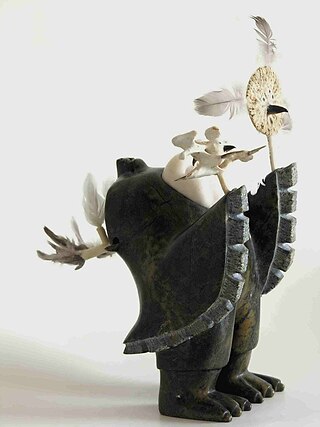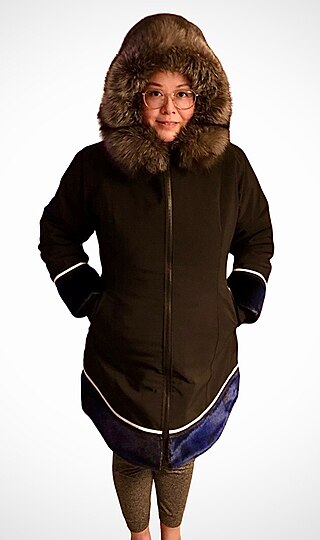Related Research Articles

Rankin Inlet is an Inuit hamlet on the Kudlulik Peninsula in Nunavut, Canada. It is the largest hamlet and second-largest settlement in Nunavut, after the territorial capital, Iqaluit. On the northwestern Hudson Bay, between Chesterfield Inlet and Arviat, it is the regional centre for the Kivalliq Region.

The Kivalliq Region is an administrative region of Nunavut, Canada. It consists of the portion of the mainland to the west of Hudson Bay together with Southampton Island and Coats Island. The regional centre is Rankin Inlet. The population was 11,045 in the 2021 Canadian census, an increase of 6.1% from the 2016 Census.

Coral Harbour is a small Inuit community that is located on Southampton Island, Kivalliq Region, in the Canadian territory of Nunavut. Its name is derived from the fossilized coral that can be found around the waters of the community which is situated at the head of South Bay. The name of the settlement in Inuktitut is Salliq, sometimes used to refer to all of Southampton Island. The plural Salliit, means large flat island(s) in front of the mainland.
Iqalugaarjuup Nunanga Territorial Park is a park located 8–10 km (5.0–6.2 mi) northwest of Rankin Inlet, Nunavut, Canada. The park lies in a valley that straddles the Meliadine River. Rankin Inlet's gravel road provides access to the park directly on the south side by foot or vehicle.

Inuit art, also known as Eskimo art, refers to artwork produced by Inuit, that is, the people of the Arctic previously known as Eskimos, a term that is now often considered offensive. Historically, their preferred medium was walrus ivory, but since the establishment of southern markets for Inuit art in 1945, prints and figurative works carved in relatively soft stone such as soapstone, serpentinite, or argillite have also become popular.
Arctic Co-operatives Limited is a cooperative federation owned and controlled by 32 community-based cooperative business enterprises located in Nunavut, Northwest Territories, Yukon and northern Manitoba, Canada. Arctic Co-ops coordinates resources, consolidates the purchasing power and provides operational and technical support to the community-based co-operatives to enable them to provide a wide range of services to their local member-owners. Arctic Co-ops operates in both English and Inuktitut and provides patronage dividends to the local members.
Floyd Kuptana (1964-2021) was an Inuvialuk (Inuit) artist in Canada whose work is primarily stone carvings as well as paintings and collage.
Andy Miki (1918–1982) was an Inuk artist from Arviat, Northwest Territories.
Shary Boyle is a contemporary Canadian visual artist working in the mediums of sculpture, drawing, painting and performance art. She lives and works in Toronto.
Lucy Tasseor Tutsweetok was an Inuit artist. Known for her sculptures, Tasseor Tutsweetok worked principally with grey steatite, a hard stone local to Arviat on the Nunavut mainland, where the artist moved following the closing of the North Rankin Nickel Mine in 1962. Always remaining close to the stone's original form and leaving its surface unpolished, her sculptures take maternal and family groupings as their principle themes. Notable exhibitions include: Sculpture/Inuit: Masterworks of the Canadian Arctic (1971–73), In the Shadow of the Sun: Contemporary Indian and Inuit Art in Canada (1989–91), and Indigena: Contemporary Native Perspectives in Canadian Art (1992), and a solo exhibition, her first, at the Art Gallery of Ontario (2011). In 1992, she completed a large sculpture for the Canadian Museum of Civilization. Tasseor Tutsweetok's minimalist and semi-abstract approach to carving is accompanied by calculated drawings upon the stone's surface, she shares this approach with her contemporaries Andy Miki, John Panaruk, and Elizabeth Nutaluk.
Irene Kataq Angutitok was an Inuit sculptor. Her name also appears as Katak Angutitaq.

Qaunaq Mikkigak was a Canadian artist and author. She was known primarily for sculpting but also created jewelry, story telling, drawing and performed throat singing. As an artist she was interested in arts and crafts and built works that were inspired by her imagination and emotions. She co-authored the children's books The Legend of the Fog and Grandmother Ptarmigan based on traditional Inuit stories. She was featured in the book Inuit Women Artists: Voices from Cape Dorset for her artwork and in Cape Dorset Sculpture. She died in 2020.

Elizabeth Angrnaqquaq (1916–2003) was an innovative Canadian Inuk textile artist active from the 1970s to early 2000s. Angnaqquaq's work explores textile creations while experimenting with non-traditional methods. Her style has been described as painterly for the way in which she fills the space between her figures and animals with embroidery.
Bernadette Iguptark Tongelik (1931-1980) was an Inuk artist known for her sculptural works.
Maureen Gruben is a Canadian Inuvialuk artist who works in sculpture, installation and public art.
Nicotye Samayualie is a Canadian Inuk artist from Cape Dorset, Nunavut. Samayualie specializes in drawings of still lifes and landscapes. She often uses large-format drawings to create expansive images of Cape Dorset landscapes.
Ruben Komangapik is an Inuit artist primarily known for his mixed media sculptures. He is also a musician, performing both traditional Inuit drumming and singing as well as playing bass guitar in the heavy metal band Slayvz. He was born in Iqaluit, and his home community is Pond Inlet (Mittimatalik) on the high north-east coast of Baffin Island (Qikiqtaaluk).

Victoria Kakuktinniq is a Canadian Inuk fashion designer from Nunavut. Under her label Victoria's Arctic Fashion, Kakuktinniq hand-stitches clothing such as parkas, kamiit, and other accessories. Her work has been described as a major influence in contemporary Inuit fashion. Kakuktinniq has described her work as a means of preserving Inuit traditional skills of sewing and clothing production, which has historically been a significant aspect of Inuit culture. In particular, she advocates for handmade fur garments as sustainable fashion.
Ada Eyetoaq (1934-2014) was a Baker Lake (Nunavut) Inuk artist who produced traditional Inuit art. She is primarily known for her miniature soapstone sculptures.
References
- 1 2 Linda Grussani, Acquisition Proposal for Pierre Aupilardjuk's Talking About Seals, accession #42288, Curatorial File, National Gallery of Canada, 2008.
- ↑ "Pierre_Aupilardjuk". www.thematchboxgallery.com. Retrieved 2021-03-18.
- ↑ Franchesca Hebert-Spence, Acquisition Proposal for Pierre Aupilardjuk and Sharry Boyle's Facing Forward, accession #48982, Curatorial File, National Gallery of Canada, 2020.
- 1 2 Foundation, Inuit Art. "Pierre Aupilardjuk | Inuit Art Foundation | Artist Database". Inuit Art Foundation. Retrieved 2021-03-19.
- ↑ "A Conversation with Pierre Aupilardjuk and Shary Boyle". Inuit Art Foundation. Retrieved 2021-03-19.
- ↑ General, Office of the Secretary to the Governor. "Mr. Pierre Aupilardjuk". The Governor General of Canada. Retrieved 2021-03-19.
- ↑ "Àbadakone | Continuous Fire | Feu continuel". www.gallery.ca. Retrieved 2021-03-19.
- ↑ "Earthlings". Esker Foundation | Contemporary Art Gallery, Calgary. Retrieved 2021-03-19.
- ↑ "Northern Visions: Contemporary Inuit Ceramics – Gardiner Museum". Google Arts & Culture. Retrieved 2021-03-19.
- ↑ "Nunavut's Matchbox Gallery puts its work on display in Toronto". Nunatsiaq News. 2014-04-11. Retrieved 2021-03-19.
- ↑ "Made in Kangiqliniq: Ceramics and Sculpture from Rankin Inlet". www.gallery.ca. Retrieved 2021-03-19.